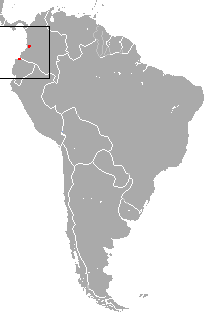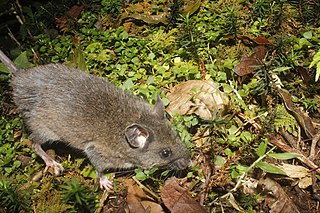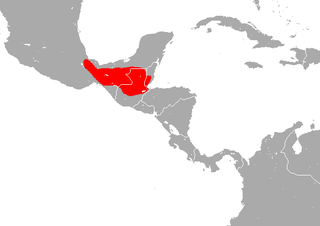
Oryzomys nelsoni is an extinct rodent of María Madre Island, Nayarit, Mexico. Within the genus Oryzomys of the family Cricetidae, it may have been most closely related to the mainland species O. albiventer. Since its first description in 1898, most authors have regarded it as a distinct species, but it has also been classified as a mere subspecies of the marsh rice rat (O. palustris).

Oryzomys is a genus of semiaquatic rodents in the tribe Oryzomyini living in southern North America and far northern South America. It includes eight species, two of which—the marsh rice rat (O. palustris) of the United States and O. couesi of Mexico and Central America—are widespread; the six others have more restricted distributions. The species have had eventful taxonomic histories, and most species were at one time included in the marsh rice rat; additional species may be recognized in the future. The name Oryzomys was established in 1857 by Spencer Fullerton Baird for the marsh rice rat and was soon applied to over a hundred species of American rodents. Subsequently, the genus gradually became more narrowly defined until its current contents were established in 2006, when ten new genera were established for species previously placed in Oryzomys.
Brucepattersonius igniventris, also known as the red-bellied akodont or red-bellied brucie, is a South American rodent in the genus Brucepattersonius. It is known only from a few specimens from the type locality in Iporanga, São Paulo, Brazil. Although it is threatened by habitat loss, it is protected by Alto Ribeira Tourist State Park.
Brucepattersonius iheringi, also known as Ihering's akodont, Ihering's hocicudo, or Ihering's brucie, is a South American rodent in the genus Brucepattersonius. It occurs in Santa Catarina and Rio Grande do Sul, southern Brazil, and nearby Misiones Province, Argentina.
The soricine brucie is a rodent species from South America. It is found in Brazil.
Nesoryzomys indefessus, also known as the Santa Cruz nesoryzomys or Indefatigable Galápagos mouse, is a rodent of the genus Nesoryzomys of family Cricetidae from Galápagos Islands of Ecuador. It contains two subspecies: one formerly lived on Santa Cruz Island, but is now extinct, probably due to the introduction of black rats; and another that is still alive on Fernandina Island. The two are sometimes considered to be different species.

The Ecuadorian sac-winged bat is a species of sac-winged bat in the family Emballonuridae. It is found in Colombia and Ecuador. According to the IUCN Red List of Threatened Species, the population trend is decreasing for this species, due to habitat destruction through deforestation. In 2013, Bat Conservation International listed this species as one of the 35 species of its worldwide priority list of conservation.
Melanomys zunigae, also known as Zuniga's melanomys or Zuniga's dark rice rat, is a species of rodent in the genus Melanomys of family Cricetidae. Known only from a small region of coastal Peru, it is listed as "critically endangered" by the IUCN and may even be extinct.

Oryzomys dimidiatus, also known as the Nicaraguan oryzomys, Thomas's rice rat, or the Nicaraguan rice rat, is a rodent in the family Cricetidae. It is known from only three specimens, all collected in southeastern Nicaragua since 1904. Placed in Nectomys upon its discovery, it was later classified in its own subgenus of Oryzomys and finally recognized as closely related to other species now placed in Oryzomys, including the marsh rice rat and Coues' rice rat, which occurs in the same region.

The zempoaltepec is a species of rodent in the family Cricetidae.
The Chihuahuan mouse is a species of rodent in the family Cricetidae.
The Sonoran harvest mouse is a species of rodent in the family Cricetidae. It is found only in Mexico.

Thomas's sac-winged bat is a species of sac-winged bat in the family Emballonuridae.
The Miahuatlán cotton rat was formerly considered a rodent species in the family Cricetidae. It is found only on the Pacific slope of the Sierra de Miahuatlán in the Mexican state of Oaxaca, where it lives in deciduous tropical forest. The IUCN currently considers it to be conspecific with Sigmodon alleni.
Brucepattersonius guarani, also known as the Guaraní akodont or Guaraní brucie, is a South American rodent in the genus Brucepattersonius. It is known from a single specimen from Misiones Province in northeastern Argentina, at the southern end of the Atlantic Forest. The species is protected by Moconá Provincial Park but is threatened by deforestation in nearby areas.
Brucepattersonius misionensis, also known as the Misiones akodont or Misiones brucie, is a rodent species from South America in the genus Brucepattersonius. It is known from a single individual collected in Misiones Province in northeastern Argentina. Its taxonomic status remains to be determined conclusively. It is threatened by habitat loss and is not known from any protected areas.
Hylaeamys tatei, also known as Tate's oryzomys or Tate's rice rat, is a South American rodent species of the family Cricetidae. It is known only from the eastern foothills of the Andes in central Ecuador, where it has been found at elevations from 1130 to 1520 m. H. tatei is most closely related to H. yunganus, which occurs throughout Amazonia. The species is found in tropical rainforest and is terrestrial and probably nocturnal. It is named after American zoologist George Henry Hamilton Tate.

The Cozumelan golden bat is a bat species from Central and northern South America. It is found in Mexico, Guatemala, Belize, Honduras, Nicaragua, Costa Rica, Panama and Colombia. At one time this species was considered to be a subspecies of the golden bat. Little is known about the biology of this bat but it has a wide range, no particular threats have been identified and the population seems steady, so the International Union for Conservation of Nature has assessed its conservation status as being of "least concern".







